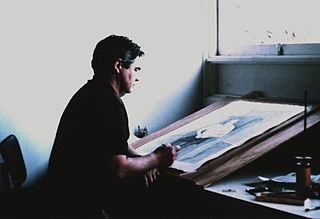Related Research Articles

The National Gallery of Victoria, popularly known as the NGV, is an art museum in Melbourne, Victoria, Australia. Founded in 1861, it is Australia's oldest and most visited art museum.

The National Gallery of Australia (NGA), formerly the Australian National Gallery, is the national art museum of Australia as well as one of the largest art museums in Australia, holding more than 166,000 works of art. Located in Canberra in the Australian Capital Territory, it was established in 1967 by the Australian Government as a national public art museum. As of 2022 it is under the directorship of Nick Mitzevich.

John Brack was an Australian painter, and a member of the Antipodeans group. According to one critic, Brack's early works captured the idiosyncrasies of their time "more powerfully and succinctly than any Australian artist before or since. Brack forged the iconography of a decade on canvas as sharply as Barry Humphries did on stage."

The Art Gallery of South Australia (AGSA), established as the National Gallery of South Australia in 1881, is located in Adelaide. It is the most significant visual arts museum in the Australian state of South Australia. It has a collection of almost 45,000 works of art, making it the second largest state art collection in Australia. As part of North Terrace cultural precinct, the gallery is flanked by the South Australian Museum to the west and the University of Adelaide to the east.
Ronald Warwick Radford is an Australian curator, who was the director of the National Gallery of Australia (NGA) from 2004 until 2014. He was previously the Director of the Art Gallery of South Australia in Adelaide.
James Mollison was acting director of the National Gallery of Australia (NGA) from 1971 to 1977 and director from 1977 to 1989. He was director of the National Gallery of Victoria from 1989 to 1995.

Thomas Lenton Parr AM was an Australian sculptor and teacher.
Richard Anthony Johnson is an Australian architect best known as the creator of some of the Australian most important and iconic cultural buildings and spaces of the twentieth century.
Alun Leach-Jones, was a British-born Australian artist known for his range of work covering painting, drawing, sculpture, linocuts, screenprints and etchings.
Allan James Myers is an Australian barrister, academic, businessman, landowner and philanthropist, and the previous Chancellor of the University of Melbourne.
Harriet Edquist is an Australian historian and curator, and Professor Emerita in the School of Architecture and Urban Design at RMIT University in Melbourne. Born and educated in Melbourne, she has published widely on and created numerous exhibitions in the field of Australian architecture, art and design history. She has also contributed to the production of Australian design knowledge as the founding editor of the RMIT Design Archives Journal and is a member of the Design Research Institute at RMIT University.
Andrew George Sayers was an Australian curator and painter. He was the first director of Australia's National Portrait Gallery from 1998 to 2010, and director of the National Museum of Australia from 2010 to 2013.
Julie Gough is an artist, writer and curator based in Tasmania, Australia.
Robert Stewart Bell was an Australian artist and arts curator, best known for his focus on decorative arts. He also worked as an artist in ceramics and textiles.
Brenda L. Croft is an Aboriginal Australian artist, curator, writer, and educator working across contemporary Indigenous and mainstream arts and cultural sectors. Croft was a founding member of the Boomalli Aboriginal Artists Cooperative in 1987.
The Prahran College of Advanced Education, formerly Prahran College of Technology, was a late-secondary and tertiary institution with a business school, a trade school, and a multi-disciplinary art school that dated back to the 1860s, populated by instructors and students who were among Australia’s significant artists, designers and performers.
Nici Cumpston, is an Australian photographer, painter, curator, writer, and educator.

Alexander "Sasha" Dmitrievich Grishin is an Australian art historian, art critic and curator based in Victoria and Canberra. He is known as an art critic, and for establishing the academic discipline of art history at the Australian National University (ANU).
Margaret Plant is a Professor of Australian art history, and as of November 2022 Emeritus Professor of Visual Arts at Monash University.
Nick Mitzevich is the director of the National Gallery of Australia (NGA) in Canberra, a position he has occupied since July 2018. From 2010 until his appointment to the NGA in April 2018, he was director of the Art Gallery of South Australia in Adelaide.
References
- ↑ Shmith, Michael; Coslovich, Gabriella (10 September 2011). "NGV's quiet director takes his leave (quietly)". The Age . Retrieved 20 January 2018.
- ↑ Boland, Michaela (20 July 2012). "Respected director leaves venerable NGV a better place". The Australian . Retrieved 20 January 2018.
- 1 2 Schmidt, Lucinda (25 May 2011). "Profile: Gerard Vaughan". The Sydney Morning Herald . Retrieved 7 October 2016.
- ↑ Who's Who in Australia 2016, ConnectWeb.[ page needed ]
- ↑ "Fellow Profile: Gerard Vaughan". Australian Academy of the Humanities. Retrieved 17 June 2024.
- ↑ "Vaughan, Gerard Ronald". It's an Honour. Australian Government. Retrieved 7 October 2016.
- ↑ "Gerard Vaughan named director of National Gallery of Australia in Canberra". The World Today . Australian Broadcasting Corporation. 16 October 2014. Retrieved 7 October 2016.
- ↑ Hardy, Karen (21 September 2017). "Gerard Vaughan retires from the National Gallery of Australia". The Canberra Times . Retrieved 2 July 2018.
- ↑ Dingwell, Doug (9 April 2017). "Nick Mitzevich confirmed new boss for National Gallery". The Sydney Morning Herald . Retrieved 2 July 2018.
- ↑ "The Cast". dartmovie.com.